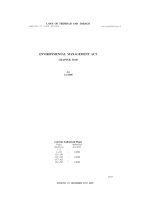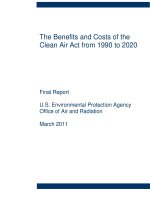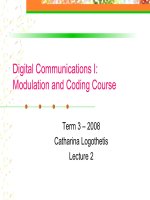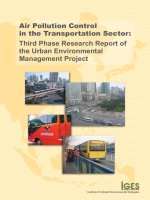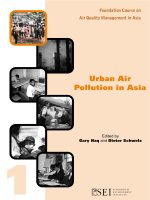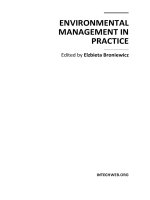Environmental management E363 lecture 2 air
Bạn đang xem bản rút gọn của tài liệu. Xem và tải ngay bản đầy đủ của tài liệu tại đây (78.02 KB, 13 trang )
E363
ENVIRONMENTAL MANAGEMENT
LECTURE 2 - AIR
Dr. Nguyen Thi Hoang Lien
NATURAL SOURCES OF AIR POLLUTION
• Volcanoes
• Fires
• Plant/Animal off gassing
• Dust storms
HUMAN CREATED AIR POLLUTION
• Major sources: transportation, electric plants
(coal, oil) and industry (steel mills, metal
smelters, oil refineries and pulp/paper mills).
• Minor sources: small engines, wood burners,
etc.
POINT SOURCES vs NON-POINT SOURCES
• Point source mean any disceminable, confined
and discrete conveyance, including but not
limited to any pipe, ditch, channel, tunnel,
conduit, well, discrete fissure, container, rolling
stock, concentrated animal feeding operation
or vessel.
• Non-point source (NPS) generally results from
land runoff, precipitation, atmospheric
deposition, etc.
NON-POINT SOURCE
•
•
-
NPS pollution can include…..
Sources for NPS:
Urban
Mining*
Forestry
Agriculture
NON-ATTAINMENT AREAS vs
ATTAINMENT AREAS
• In United States environmental law,
a nonattainment area is an area considered to
have air quality worse than the National
Ambient Air Quality Standards as defined in
the Clean Air Act Amendments of 1970 (P.L.
91-604, Sec. 109). Nonattainment areas must
have and implement a plan to meet the
standard, or risk losing some forms of federal
financial assistance. An area may be a
nonattainment area for one pollutant and an
attainment area for others.
INDOOR AIR POLLUTION SOURCES
• Combustion sources
• Building materials & furnishing
• Products
for
household
clearing
&
maintenance, personal care or hobbies
• Central heating & cooling systems &
humidification devices
• Outdoor sources such as radons, pesticides,
outdoor air pollution
HEALTH BASED CRITERIA
Health based criteria for (science based
guidelines) primary standard = protects health
secondary standard = prevents environmental
and property damage.
CRITERIA AIR POLLUTANTS
•
•
•
•
•
•
PM 2.5
SO2
CO
NOx
O3
Pb-Lead
LAW ON ENVIRONMENTAL
PROTECTION 2005
Chapter 8 - Section 5: Management and
control of dust, gases, noise, vibration, light
and radiation.
Article 83.- Management and control of dust
and gas emissions.
Article 84.- Management of greenhouse gases
and ozone layer-depleting gases.
Article 85.- Restriction of noise, vibration, light
and radiation.
NATIONAL TECHNICAL REGULATIONS
• QCVN 02:2008/BTNMT: National technical
regulation on the emission of health care
solid waste incinerators.
• QCVN 05:2009/BTNMT: National technical
regulation on ambient air quality.
• QCVN 06:2009/BTNMT: National technical
regulation on hazardous substances in
ambient air.
• QCVN 19:2009/BTNMT: National technical
regulation on industrial emission of inorganic
substances and dusts.
• QCVN 20:2009/BTNMT: National technical
regulation on industrial emission of organic
substances.
• QCVN 21:2009/BTNMT: National technical
regulation
on
emission
of chemical fertilizer manufacturing industry.
• QCVN 22:2009/BTNMT: National technical
regulation on emission of thermal power
industry.
• QCVN 23:2009/BTNMT: National technical
regulation
on
emission
of
cement
manufacturing industry.
• QCVN 26:2010/BTNMT: National technical
regulation on noise.
• QCVN 27:2010/BTNMT: National technical
regulation on vibration.
• QCVN 30:2010/BTNMT: National technical
regulation on emission of industrial waste
incinerators.
• QCVN 34:2010/BTNMT: National technical
regulation on emission of refining and
petrochemical
industry
of
inorganic
substances and dusts.



